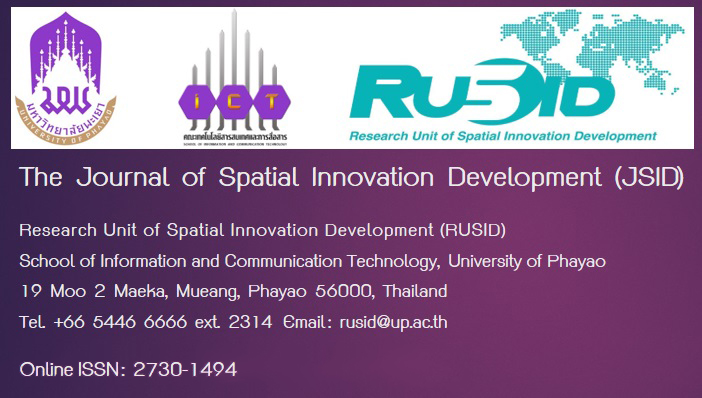Guidelines for the Development of Homestay for Creative Tourism in Pak Bara Bay Community, Satun Province
Keywords:
Participatory Action Research, Homestay, Creative Tourism, Pak Bara Bay CommunityAbstract
The purpose of this article are to evaluate the potential and readiness for developing a homestay in Pak Bara bay community using a community-based process. In addition, to find a way to develop homestays in Pak Bara bay community for creative tourism which is Participatory Action Research (PAR). In-depth interviews, focus group discussion and observation data used for collated data. The key informants purposely selected, totaling 23 people from three groups: government sector, homestay operators and local communities. Data were analyzed using SWOT analysis and content analysis. The study results found that the Pak Bara bay community has strengths in terms of its distinctive way of life and occupations based on local wisdom. This new form of tourism has expanded greatly and the good opportunity is that Thai tourists are increasingly interested in community tourism. However, there are weaknesses in the lack of knowledge and understanding about homestay tourism and the lack of a tourist attraction database system. Guidelines for developing Pakbara bay community homestays for creative tourism are 1) preparation of place and activities; 2) engage with the community to think, plan, operate and receive benefits equally; 3) having leaders with high leadership skills; 4) increasing public relations through various channels; 5) distributing income by promoting product creation in groups; and 6) managing tourism by taking into account the balance between the needs of tourists and local communities.
References
กนกรัตน์ ดวงพิกุล และ จารุนันท์ เมธะพันธุ์. (2561). โฮมสเตย์กับการท่องเที่ยวอย่างยั่งยืนในจังหวัดน่าน. วารสารบัณฑิตวิจัย, 9(1), 217-234.
กรมการท่องเที่ยว กระทรวงการท่องเที่ยวและการกีฬา. (2560). คู่มือการบริหารจัดการแหล่งท่องเที่ยวเชิงสร้างสรรค์. กรุงเทพฯ: กระทรวงการท่องเที่ยวและการกีฬา.
เขมิกา ธีรพงษ์. (2563). การพัฒนาการท่องเที่ยวเชิงวัฒนธรรมด้วยการออกแบบประสบการณ์. ศิลปกรรมสาร, 13(1), 1-15.
นาตยา เกตุสมบูรณ์ และ วันทนา เนาว์วัน. (2562 ). ศักยภาพด้านการท่องเที่ยวเพื่อการพัฒนาหมู่บ้านท่องเที่ยว หมู่บ้านหนองสรวง ตำบลกระแซง อำเภอบางไทร จังหวัดพระนครศรีอยุธยา. วารสารสมาคมสถาบันอุดมศึกษาเอกชนแห่งประเทศไทย ในพระบรมราชูปถัมภ์ สมเด็จพระเทพรัตนราชสุดาฯสยามบรมราชกุมารี, 25(1), 81-93.
พนิตสุภา ธรรมประมวล และ กาสัก เต๊ะขันหมาก. (2564). กลยุทธ์การจัดการการท่องเที่ยวชุมชนเชิงวัฒนธรรมบนฐานทุนทางวัฒนธรรมของกลุ่มโฮมสเตย์ไทยเบิ้งบ้านโคกสลุง อำเภอพัฒนานิคม จังหวัดลพบุรี. วารสารปัญญาภิวัฒน์, 13(2), 109-128.
พิทักษ์ ศิริวงศ์ และ นรินทร์ สังข์รักษา. (2560). การพัฒนาที่พักแบบโฮมสเตย์ในแหล่งท่องเที่ยวเมืองโบราณอู่ทอง.Veridian E-Journal, Silpakorn University ฉบับภาษาไทย สาขามนุษยศาสตร์ สังคมศาสตร์ และศิลปะ, 10(2), 2282-2293.
วิโชคศักดิ์ รณรงค์ไพรี. (2562). “การท่องเที่ยวอ่าวปากบารา” ดุลยภาพทางอำนาจใหม่ของชุมชนและรัฐ อานิสงส์จากการต่อสู้ท่าเรือน้ำลึก. สืบค้นจาก https://mgronline.com/south/detail/9620000017564.
ภาวิณี หาญณรงค์. (2557). การศึกษาคุณภาพโฮมสเตย์กระชังแพ เพื่อการท่องเที่ยว กรณีศึกษา โฮมสเตย์กระชังแพ ตำบลเพ อำเภอเมือง จังหวัดระยอง. (ศิลปศาสตรมหาบัณฑิต). สาขาวิชาการจัดการการท่องเที่ยว คณะการท่องเที่ยวและการโรงแรม, มหาวิทยาลัยธุรกิจบัณฑิตย์, กรุงเทพฯ.
สัญญา ยือราน และ ศิวิไลซ์ วนรัตน์วิจิตร. ( 2561). การวิจัยเชิงปฏิบัติการแบบมีส่วนร่วม สู่ความสำเร็จการเปลี่ยนแปลงนโยบายในระบบสุขภาพ. วารสารเครือข่ายวิทยาลัยพยาบาลและการสาธารณสุขภาคใต้, 5(2), 288-300.
สำนักงานจังหวัดสตูล. (2562). แผนพัฒนาจังหวัดสตูล 5 ปี (พ.ศ. 2561 - 2565) ฉบับทบทวน (27 ธ.ค. 62). สืบค้นจาก http://www2.satun.go.th/news_devpro.
สำนักงานจังหวัดสตูล. (2565). แผนงานยุทธศาสตร์ที่ส่งเสริมการพัฒนาจังหวัดและกลุ่มจังหวัดแบบบูรณาการ จังหวัดสตูล. สืบค้นจาก http://www.satun.go.th/content/vision.
เสรี วงษ์มณฑา. (2564). การท่องเที่ยวเชิงสร้างสรรค์: นวัตกรรมการเคลื่อนขยับของการท่องเที่ยวเชิงวัฒนธรรม. วารสารศิลปศาสตร์ (วังนางเลิ้ง) มทร. พระนคร, 1(1), 1-24.
อัจฉรา เมฆสุวรรณ ขจรศักดิ์ วงศ์วิราช และเนตรดาว โทธรัตน์. (2563). แนวทางการพัฒนาสมรรถนะโฮมสเตย์ของการท่องเที่ยว สร้างสรรค์เชิงวัฒนธรรมผ่านการมีส่วนร่วมของชุมชน จังหวัดลำปาง. วารสารวิชาการวิทยาลัยบริหารศาสตร์, 3(2), 106-112.
อัญญารัตน์ ธราวรรณ และ มรีวรรณ ผิวนิ่ม. (2557). การศึกษาผลกระทบทางสังคมและวัฒนธรรมจากการท่องเที่ยว กรณีศึกษา เมืองเชียงคาน ตำบลเชียงคาน อำเภอเชียงคาน จังหวัดเลย. การประชุมวิชาการเสนอผลงานวิจัยระดับบัณฑิตศึกษา ครั้งที่ 15 : 50 ปี มข. แห่งการอุทิศเพื่อสังคม. วันที่ 28 มีนาคม 2557 (น. 2880-2886). ขอนแก่น: วิทยาลัยการปกครองท้องถิ่นและอาคารพิมลกลกิจ มหาวิทยาลัยขอนแก่น.
Khao Yai DD. (2566). รีสอร์ทและโฮมสเตย์ต่างกันยังไง ใครที่ชอบเที่ยวต้องรู้ไว้. สืบค้นจาก https://khaoyaidd.com/blog/.
Amir, A. F., Ghapar, A. A., Jamal, S. A., & Ahmad, K. N. (2014). Sustainable tourism development: A study on community resilience for rural tourism in Malaysia. Procedia -Social and Behavioral Sciences, 168(2015), 116-122.
Harmes-Liedtke, U., & Mannocchi, L. (2012). Complexities of tourism development – viewpoints of development practitioner Pat3, Journal of Public Policies and territories, 1(3), 45-56.
Janjua, Z. U. A., Krishnapillai, G., & Rahman, M. (2021). A systematic literature review of rural homestays and sustainability in tourism. SAGE Open, 11(2), 1-17.
Janusz, G. K., & Bajdor, P. (2013). Towards to Sustainable Tourism - Framework, Activities and Dimensions. Procedia Economics and Finance, 6(2013), 523-529.
Richards, G. (2009). Creative tourism and local development. In R. Wurzburger, A. Pattakos, & S. Pratt (Eds.), Creative tourism: A global conversation (pp. 78-90). Sunstone Press.
Richards, G. (2010). Creative tourism and local development. In R. Wurzburger (Ed.), Creative tourism: A global conversation: How to provide unique creative experiences for travelers worldwide: At present at the 2008 Santa Fe & UNESCO International Conference on Creative Tourism in Santa Fe. (pp. 78-90). New Mexico: USA.
Wurzburger, R. (2010). Introduction to the Santa Fe & UNESCO International Conference: A global conversation on best practices and new opportunities. In R. Wurzburger (Ed.), Creative tourism: A global conversation: How to provide unique creative experiences for travelers worldwide: At present at the 2008 Santa Fe & UNESCO International Conference on Creative Tourism in Santa Fe. (pp. 15-25). New Mexico: USA.





